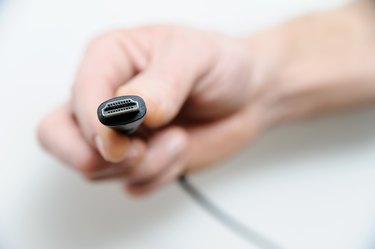
There's a lot of streaming content available online, but it's not fun to watch with others when you're hunched over a laptop screen. A better alternative is to hook your laptop up to your TV. It's easy with newer laptops equipped with an HDMI port, but you still have options with older laptops. An adapter may solve your connection problem or you may even be able to connect wirelessly.
Laptop to TV Cable Connections
Video of the Day
If you have the right cable, you can connect the video-out connector on your laptop to the video-in connector on your TV. This will send the display from your laptop to your television screen. Experts recommend making sure that your laptop is powered off when you connect it to a TV with a cable. When you power it up and turn on the TV, it should be recognized by your laptop as an external display device.
Video of the Day
Newer laptops are equipped with HDMI (High-Definition Multimedia Interface), a type of connection that provides the highest quality. DVI (Digital Video Interface) is an older connection that you'll find more often on desktop computers than laptops. VGA (Video Graphics Adapter) is an even older connection that utilizes analog rather than digital signals. On Apple computers like the MacBook, you may find a Thunderbolt connector instead of HDMI. You may still be able to connect all of these to HDMI with the right adapter.
Hookinh Up a Laptop to TV with HDMI
If you have a Windows and Mac laptops equipped with an HDMI port, you can connect one end of an HDMI cable directly to this port and connect the other end to the TV's HDMI port. Then change the display source on your TV to the correct HDMI port (many television sets have more than one). If it seems that the HDMI cable is not working, you may also have to adjust your laptop or MAC settings to set your display resolution correctly for television display.
If your television has an HDMI connector but your laptop doesn't, you can purchase an inexpensive adapter, a piece of hardware that that plugs into your laptop. The HDMI from the TV also plugs into the adapter. You can purchase HDMI adapters for DVI, VGA, DisplayPort, Thunderbolt and other connection types. Once the adapter is connected to the laptop and the HDMI cable from the TV is connected to the adapter, everything should work as it does for an HDMI-to-HDMI connection.
USB to HDMI
Some smart TVs have a USB port that can be used to display media like photos on the TV display. The USB port on the TV is not intended to serve as a channel for video in. Connecting a USB cable from a laptop to a TV that's equipped with a USB port will not allow the laptop's display to be directed to the TV. Instead, you can use a USB-to-HDMI adapter that's designed for a computer or laptop. Like other types of HDMI adapters, it will make your laptop look like an HDMI device to your TV.
Wireless Connection from Laptop to TV
If using a cable to connect your TV to your laptop is inconvenient, you can use a device like the Google Chromecast or Apple TV to connect your TV to the same network as your laptop and view content from your laptop on your TV display. Windows 10 users who have laptops and TVs with Miracast support can "mirror" the display on their laptops on their TVs.
The technology lets you present a slide show or play a video game and see it displayed on your TV display. If your laptop supports Miracast but your TV doesn't, you can plug a Miracast adapter into your TV's HDMI port.